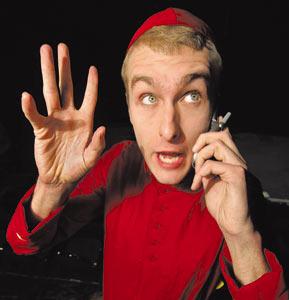This month, actor Christopher Kehoe will play a gentle, lovestruck young man in a play written by Pope John Paul II. A few weeks later, he'll portray a control-freak cardinal in another show that satirizes the pontiff and the Catholic church.
"It didn't really occur to me that I would be doing two pope-linked shows until after the fact," the 21-year-old University of Minnesota junior said. "I just didn't want to fall into a rut as a performer."
"The Pope and the Witch," scheduled for a March opening at the University of Minnesota Theatre, is a hot topic. Word of the production spurred a vociferous response from area Catholics and prompted Minnesota's bishops to ask the university to pull the play.
Lesser known is an upcoming production of "The Jeweler's Shop," written in 1960 by a Polish archbishop who would be elevated to the papacy 18 years later. Commedia Beauregard, a small itinerant company, will stage the poetic meditation on love, marriage and faith for three weekends in January at the Loading Dock Theatre in St. Paul's Lowertown neighborhood.
"Jeweler's Shop" artistic director Chris Kidder insists his production isn't about capitalizing on the publicity surrounding "The Pope and the Witch." "It's 100 percent coincidence," he said. "I wish I could say I had the foresight to do something like that."
Kidder, who is not Catholic, said he came upon the script in the months preceding the 2005 death of John Paul II. "I had pitched it to a couple other small theaters where I've directed, but it fell back to me, and I figured I've got to do it."
"The Jeweler's Shop" is an atmospheric, metaphoric play. Each of its three acts focuses on a married couple at various stages in their relationship. Adam, the omnipresent jeweler of the title, oversees and comments on the action of the play as a Godlike figure. Its raciest scene depicts a woman so starved for love from her husband that she takes to wandering the streets, where she is mistaken for a prostitute.
By contrast, "The Pope and the Witch," by Nobel prize-winning playwright Dario Fo, is much more physical and hard-edged, directly confronting church doctrine on birth control and other issues. It portrays the Vatican as a bureaucracy obsessed more with spin control than spirituality.
Written during the papacy of John Paul II, Fo's script portrays a nameless pontiff as a well-intentioned but hapless character — in one scene, a "healer" tries to cure him of a delusional fit through hypnosis; in another, he's unwillingly shot up with a heroin mixture used by a pair of gangsters as a truth serum.
The archdiocese of St. Paul and Minneapolis condemned "The Pope and the Witch" but stopped short of calling for a boycott of the production or protests at the university.
Spokesman Dennis McGrath said the Twin Cities archdiocese endorses the production of "The Jeweler's Shop." "We wouldn't consider it a quid pro quo in terms of what's happening at the University of Minnesota in March, but I know I'm interested in seeing it, and I know that a number of our priests would be, as well."
"The Jeweler's Shop" is the best known of the half-dozen or so plays John Paul wrote. It was produced off-Broadway in 1994 and was adapted into a 1988 movie starring Burt Lancaster.
Karol Wojtyla started acting at age 8 and worked on and wrote about the arts throughout his life, said David Scott, a Catholic author and former editor of Our Sunday Visitor, the independent Catholic newspaper. The pontiff published a book of poems, "Roman Triptych," in 2003. In the summer of 1941, the 21-year-old Wojtyla co-founded an experimental underground troupe called the Rhapsodic Theater in Poland.
Wojtyla left the Rhapsodic in 1944 to begin studying for the priesthood, but he remained interested in theater. In the 1950s and '60s, he published reviews of several plays — including his own — under pseudonyms. Scott said John Paul was consistent in his aesthetic and pastoral output and that "The Jeweler's Shop" ties neatly into his theology.
"He's writing about the marriage relationship, but he's talking about the relationship between God and us," Scott said. "He's advocating for a love so deep that when two meet, they become one flesh. It's the same thing as Jesus becoming true God and true man."
Fo, by contrast, has long been an aesthetic bomb thrower. According to the New York Times, he was twice denied a visa to enter the United States in the 1980s under a section of the Immigration and Nationality Act that excluded aliens who are members of or who support anarchist, communist or terrorist organizations.
His plays — the best known is "Accidental Death of an Anarchist" — have long rankled established governments and religious organizations. One of his most recent works is "Peace Mom," a one-woman play about Iraq war protester Cindy Sheehan, who camped out at President Bush's Texas ranch in 2005.
All of which makes appearing in the attention-grabbing "The Pope and the Witch" an enticing possibility for a young actor like Kehoe.
Which of his pope-related roles does he expect will be more fun to play?
"Well, 'The Pope and the Witch' is a comedy," he said. "It's much more physical, and so it will probably be more fun," said Kehoe. "But 'The Jeweler's Shop' is a very different kind of play, and right now I'm focused on that." Pioneer Press

2 comments:
Besides talking what are we doing about this?
Praying.
Post a Comment